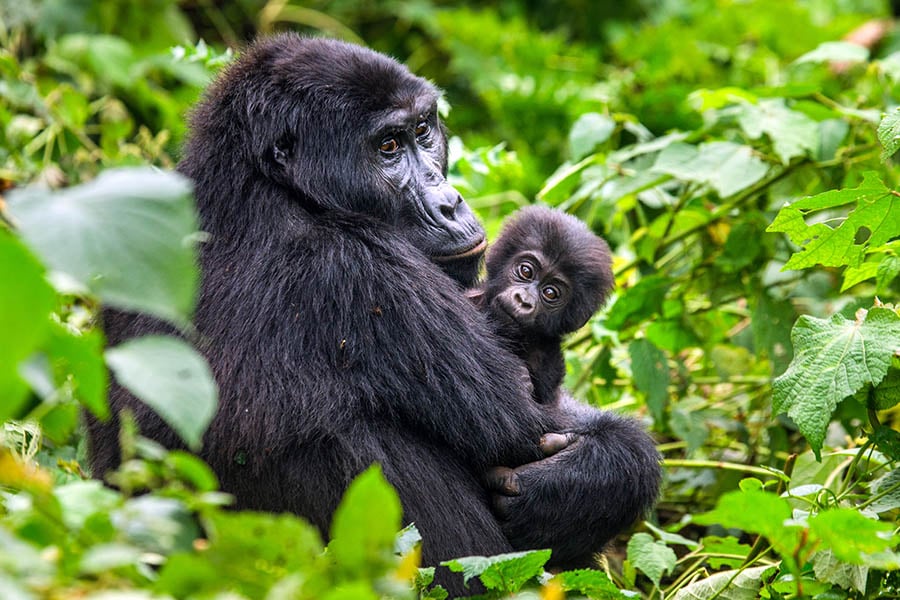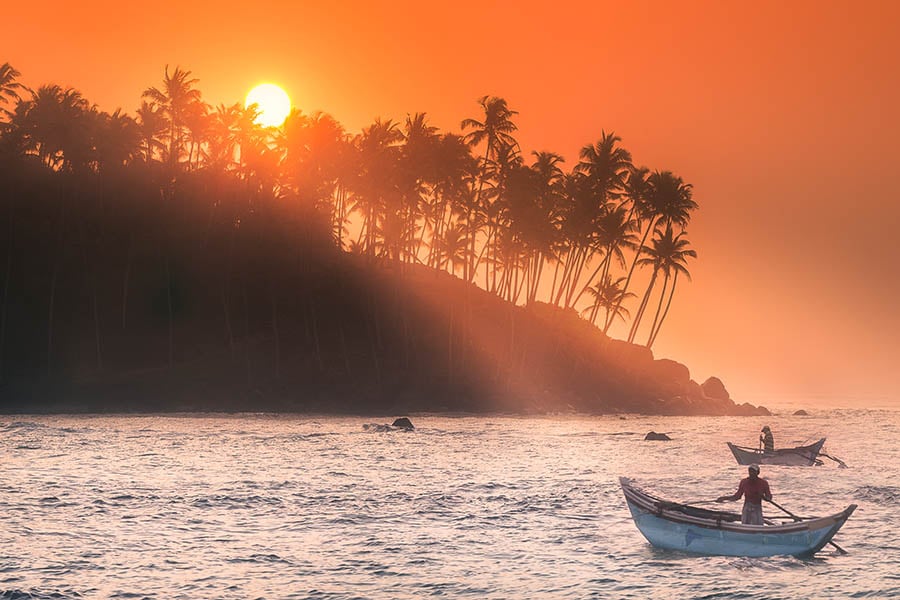When is the best time to visit Fiji?
Home to 333 castaway islands and some of the friendliest people on the planet, Fiji is a bucket-list favourite. An irresistible medley of coconut palms, soft white sands, lush forests, and clear blue seas, it’s the South Pacific paradise that you’ve always imagined.
But when is the best time to visit Fiji? Here’s our guide to travelling to Fiji, complete with tips from our very own travel experts. Hopefully, it will help you plan the island-hopping adventure of a lifetime!

Fiji’s climate in a nutshell
Fiji has a tropical maritime climate. This means that the temperature varies only a little from month to month. In general, it holds steady around 28 degrees Celsius, so you’ll never feel much of a chill. Even the water temperature rarely dips below 25 degrees, so you can swim on a year-round basis.
In contrast, the rainfall levels vary wildly, swinging between 45mm in July to 275mm in January on some of the islands. It’s this humidity and tropical rainfall that keeps Fiji so green and fresh.
When is the dry season in Fiji?
Broadly speaking, the dry season, locally known as ‘Fijian winter’ runs from May to October, while the wet season stretches from November until the end of April. The dry season brings lower humidity, less rainfall and slightly better water visibility for diving and snorkelling. It’s the sun-drenched paradise that you’ve always imagined it to be.
If you’re determined to avoid any risk of rain, it’s best to travel in July or August, when there are usually only four days of rain per month. You’re practically guaranteed steady South Pacific sunshine. However, with the Antipodean schools out for winter holidays and the European schools out for summer, it’s peak season. You’ll need to brace yourself for busier resorts and higher prices.

Shoulder season - our favourite time to visit Fiji
For us, the best time to visit Fiji is during the transitional ‘shoulder season’ months. This is the very beginning of the dry season in late April and May or the very end of the dry season in October. These months are magical in Fiji because they offer the best of both worlds – lots of sunshine with little crowds. Accommodation is great value for money and availability is generally good. What’s not to like?

In late April and May, the rains begin to subside, leaving the islands lush, fresh, and vibrantly green. As long as you avoid the Easter school holidays, you’re in for a laidback trip with quiet beaches and pretty reliable sunshine. At the end of the dry season in October, you can expect mild temperatures and sunny days without fully-booked resorts and peak prices. Perfect!
Is it worth visiting Fiji during the wet season?
Absolutely! The rainy season isn’t a complete washout, by any means. It’s more of a mixed bag of sunshine and rain. You’re still likely to see plenty of beautiful sunshine during the wet season in Fiji, but you’ll also see plenty of rain. The sunshine is punctuated by daily heavy showers, but not dominated by them.
Mornings often begin clear and sunny before the humid heat builds into a dramatic afternoon downpour. The storms tend to pass quickly, giving way to spectacular sunsets.

Even in March, the wettest month in Fiji, on average there are 16 days with some level of rainfall. That’s only a roughly 50/50 chance of rain – so the odds aren’t bad at all. In other words, don’t let a little rain dampen your spirits. When the skies darken, you can duck inside for a nap or grab an afternoon cocktail at the bar.
There are lots of benefits to travelling in Fiji during the wetter months, especially if you’re looking for a quiet - and more affordable - escape. During the rainy season, availability is good, prices are lower, and tourist numbers are far lower. Often, resort prices are as much as 30% lower than during peak season. We love a ‘green season’ escape to Fiji – it’s paradise at a fraction of the price!

Fiji’s off-peak festivals
There are also a handful of brilliant and fascinating local festivals that take place during Fiji’s rainy season. Fiji’s Hindus celebrate Holi in March, throwing a rainbow of coloured powder with great gusto. The religious Hindu festival of Ram Naumi also takes place in late March or early April, with worshippers floating tropical flowers in Suva Bay. This is followed by the Fire Walking Festivals, usually held in late April.
By far the most unusual of Fiji’s festivals is held in November, right at the beginning of the rains. Known as the ‘harvest of the reef’, the Balolo Rising sees edible blue worms floating to the surface in their millions to reproduce. Apparently, it’s the ‘caviar of the South Pacific’. The balolo usually rises after midnight on the eighth day after the full moon and you can see the phenomenon in several locations in Vanua Levu, Yasawas, Mamanucas, Vatulele, Kadavu, Lomaiviti and Taveuni.

What about cyclones?
Between December and March, when humidity and rainfall are high, there is a chance of cyclones forming over Fiji. The same applies to all the tropical and subtropical regions all over the planet. Most of the time, these cyclones are no worse than heavy storms and pass through quickly. There have only been 10 to 15 cyclones in Fiji over the past decade and the Fijians have a brilliant warning system in place, so that should set your mind at rest.

Is the weather the same everywhere in Fiji?
Absolutely not. There are dozens of microclimates at play across Fiji’s 333 islands, creating dramatically different weather systems in different places. Some areas are naturally sheltered from the southeast trade winds, while others are rainy pockets exposed to the elements. For example, the mountainous interior means that the east coast of Viti Levu receives over double the amount of rainfall as the west coast. Incredible!
The great news is that plenty of Fiji’s beaches and islands are protected from the worst of the weather. The dreamy Mamanuca and Yasawa Islands receive less rainfall than anywhere else in Fiji, with reliably sunny skies, clear waters, and picture-postcard sands. Denarau Island, another popular holiday spot just outside Nadi, also sits in a sheltered spot.

Ready to plan your trip to Fiji?
If you don’t mind a few tropical downpours, Fiji is a year-round destination with glorious landscapes, beautiful beaches and a totally entrancing local culture. The food is delicious, the people are unbelievably welcoming, and the underwater world is spectacular. Whenever you choose to visit Fiji, you’ll be glad that you did. There really is nowhere quite like it.
At Travel Nation, we’re South Pacific experts. We can create unforgettable Fiji holidays of all shapes and sizes. Whether you’re after a family adventure, a romantic escape, or an active adventure, we can help. Simply get in touch to find out more.

How to choose the best island in Fiji for you

Bryony Dunn
Marketing Manager
at Travel Nation

6 Luxury Fiji resorts that will leave you speechless

Milly Gill
Product Manager
at Travel Nation

Exploring the Yasawa Islands: my Fiji family holiday

Chris West
Senior Travel Consultant
at Travel Nation

About the author Bryony Dunn
Marketing Manager
Bryony is an explorer in every sense of the meaning. In 2013 she took the plunge, quit her marketing job and decided to face down her lifelong panic disorder to begin life as a freelance digital nomad. Journeying all over Asia, for years she earned her keep writing for travel brands. Almost by accident, she ended up in Cali, Colombia where she discovered a remarkable (as yet latent) talent for Salsa dancing. After spending a year in sequins shimmying from dance show to dance show, she returned to the UK, tanned, toned and ready to settle down. Bryony joined Travel Nation as a round the world specialist in 2016 and is now the Marketing Manager, with a little salsa on the side.





















